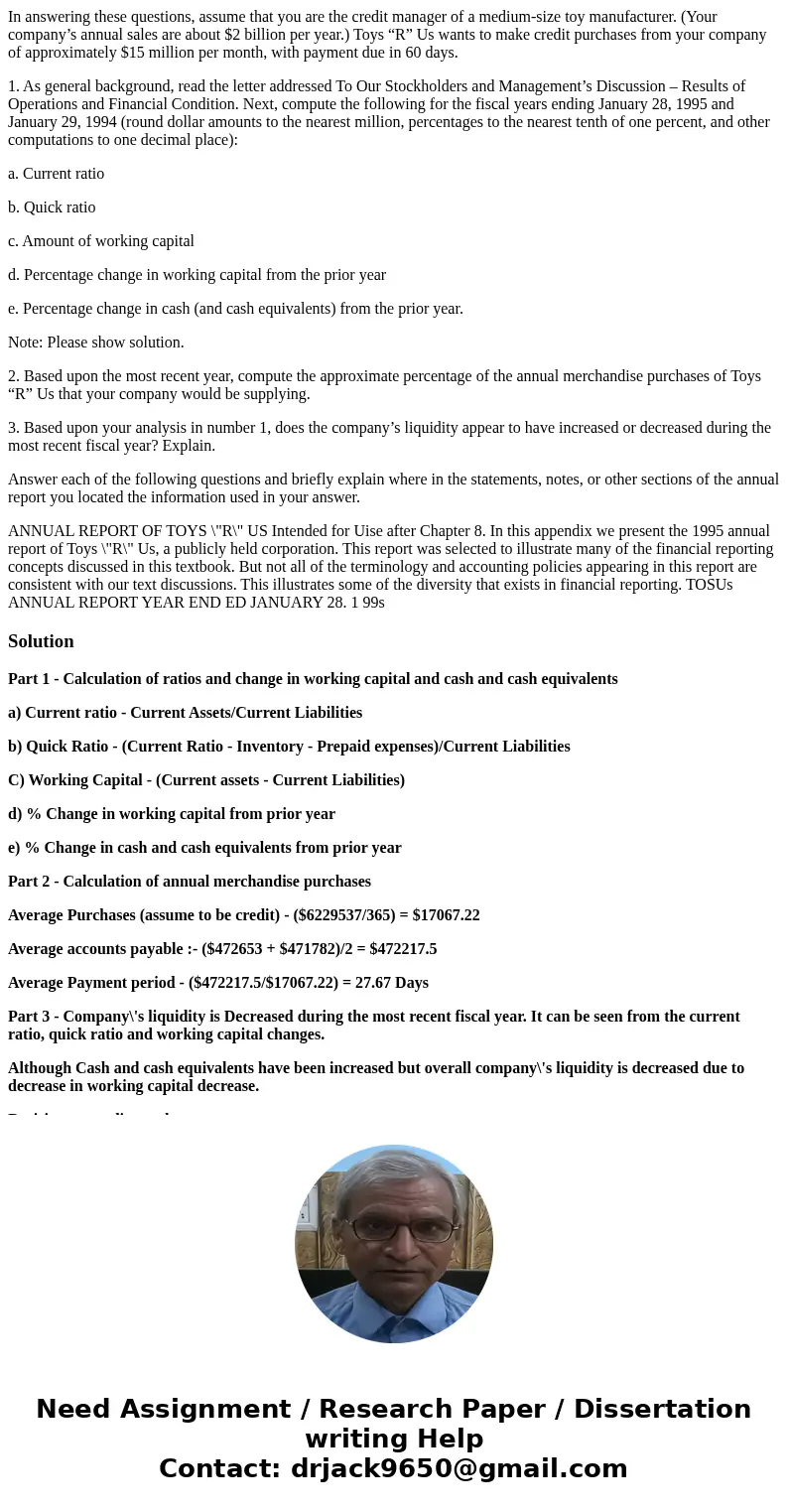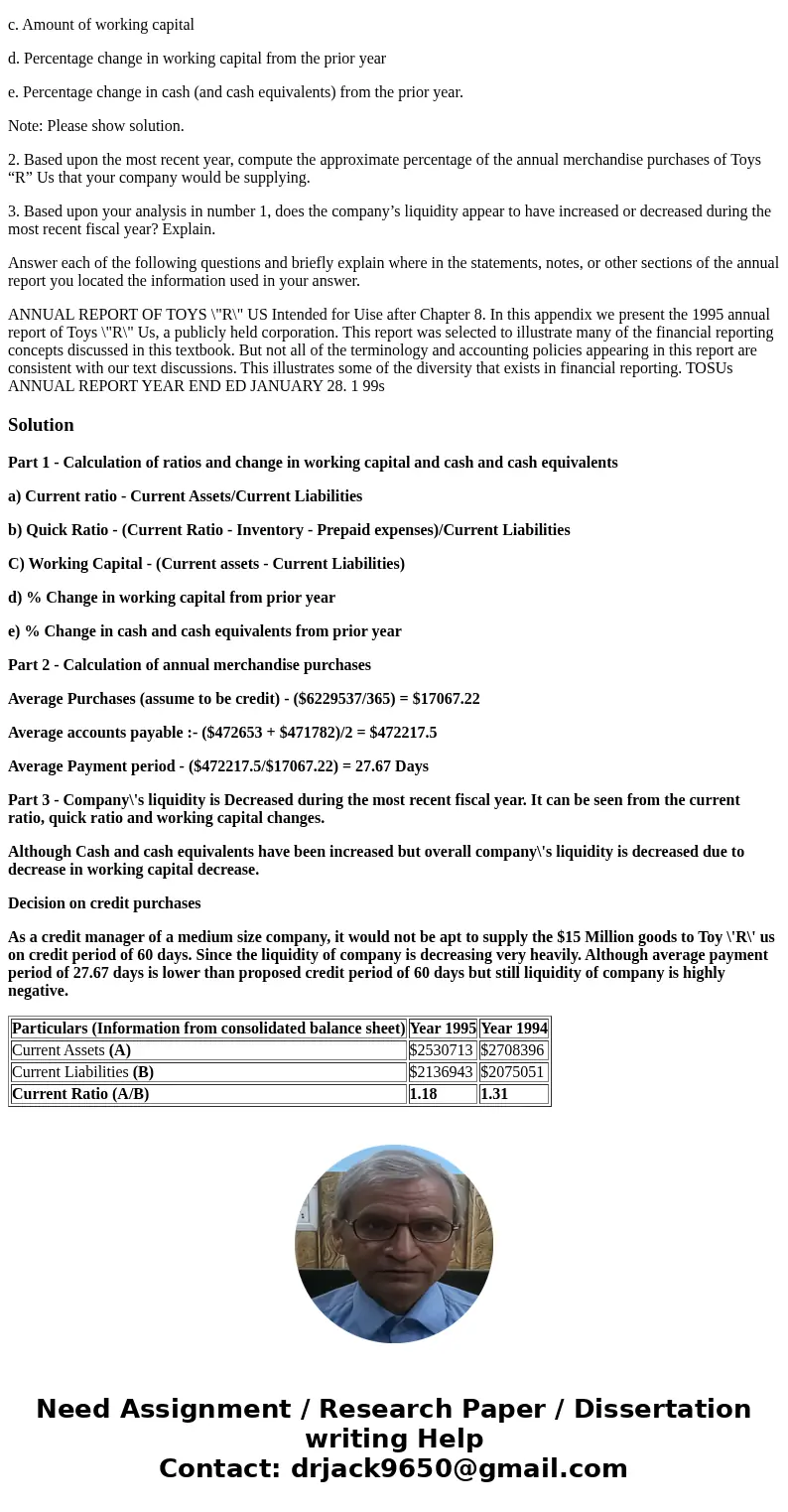In answering these questions assume that you are the credit
In answering these questions, assume that you are the credit manager of a medium-size toy manufacturer. (Your company’s annual sales are about $2 billion per year.) Toys “R” Us wants to make credit purchases from your company of approximately $15 million per month, with payment due in 60 days.
1. As general background, read the letter addressed To Our Stockholders and Management’s Discussion – Results of Operations and Financial Condition. Next, compute the following for the fiscal years ending January 28, 1995 and January 29, 1994 (round dollar amounts to the nearest million, percentages to the nearest tenth of one percent, and other computations to one decimal place):
a. Current ratio
b. Quick ratio
c. Amount of working capital
d. Percentage change in working capital from the prior year
e. Percentage change in cash (and cash equivalents) from the prior year.
Note: Please show solution.
2. Based upon the most recent year, compute the approximate percentage of the annual merchandise purchases of Toys “R” Us that your company would be supplying.
3. Based upon your analysis in number 1, does the company’s liquidity appear to have increased or decreased during the most recent fiscal year? Explain.
Answer each of the following questions and briefly explain where in the statements, notes, or other sections of the annual report you located the information used in your answer.
ANNUAL REPORT OF TOYS \"R\" US Intended for Uise after Chapter 8. In this appendix we present the 1995 annual report of Toys \"R\" Us, a publicly held corporation. This report was selected to illustrate many of the financial reporting concepts discussed in this textbook. But not all of the terminology and accounting policies appearing in this report are consistent with our text discussions. This illustrates some of the diversity that exists in financial reporting. TOSUs ANNUAL REPORT YEAR END ED JANUARY 28. 1 99sSolution
Part 1 - Calculation of ratios and change in working capital and cash and cash equivalents
a) Current ratio - Current Assets/Current Liabilities
b) Quick Ratio - (Current Ratio - Inventory - Prepaid expenses)/Current Liabilities
C) Working Capital - (Current assets - Current Liabilities)
d) % Change in working capital from prior year
e) % Change in cash and cash equivalents from prior year
Part 2 - Calculation of annual merchandise purchases
Average Purchases (assume to be credit) - ($6229537/365) = $17067.22
Average accounts payable :- ($472653 + $471782)/2 = $472217.5
Average Payment period - ($472217.5/$17067.22) = 27.67 Days
Part 3 - Company\'s liquidity is Decreased during the most recent fiscal year. It can be seen from the current ratio, quick ratio and working capital changes.
Although Cash and cash equivalents have been increased but overall company\'s liquidity is decreased due to decrease in working capital decrease.
Decision on credit purchases
As a credit manager of a medium size company, it would not be apt to supply the $15 Million goods to Toy \'R\' us on credit period of 60 days. Since the liquidity of company is decreasing very heavily. Although average payment period of 27.67 days is lower than proposed credit period of 60 days but still liquidity of company is highly negative.
| Particulars (Information from consolidated balance sheet) | Year 1995 | Year 1994 |
| Current Assets (A) | $2530713 | $2708396 |
| Current Liabilities (B) | $2136943 | $2075051 |
| Current Ratio (A/B) | 1.18 | 1.31 |


 Homework Sourse
Homework Sourse